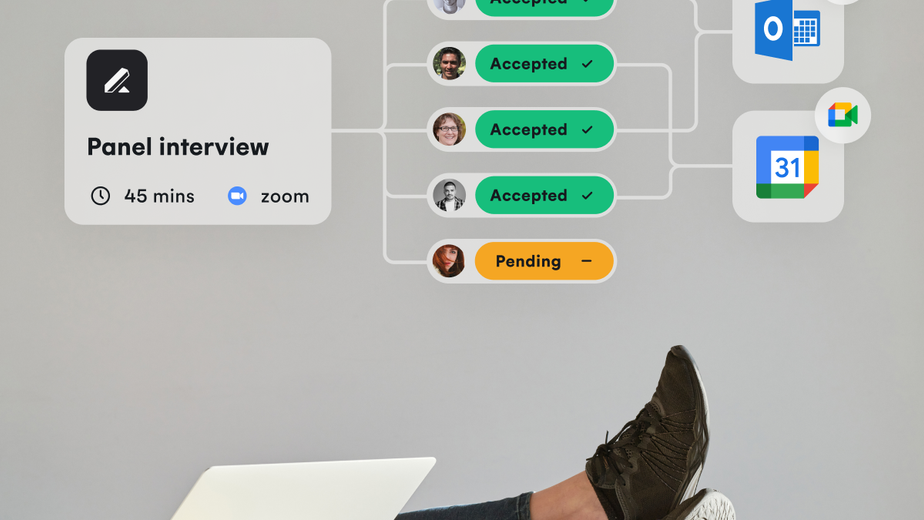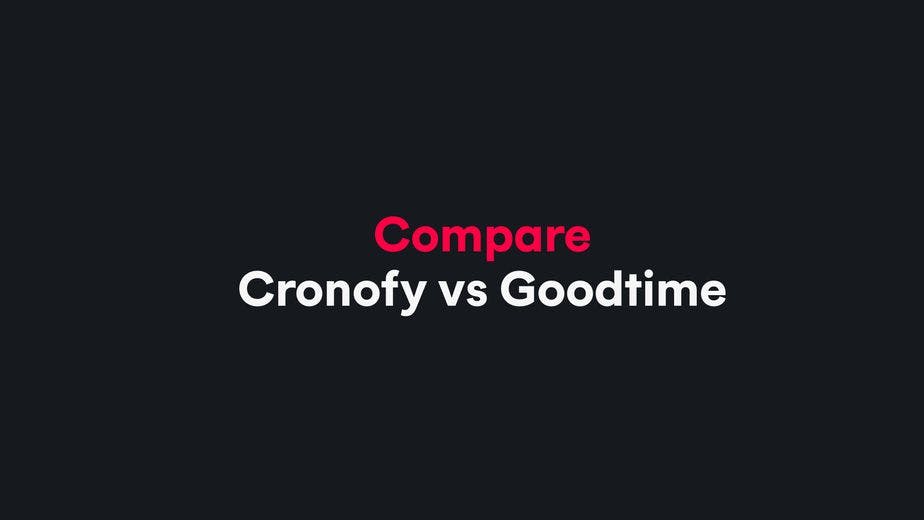Too long, too complicated, too disjointed.
That’s the general sentiment of candidates across the interweb on the current trend in recruitment. What’s worse is that candidates hold remote-first or hybrid companies to a much higher expectation in the recruitment process, “all my interviews will be virtual so I expect this to be faster.”
On the other end of the recruitment process is a swamped recruiter dealing with an overwhelming number of candidates applying per role given the scarcity of remote roles versus candidates seeking remote opportunities. Top that with no face-to-face interaction and it’s an unmitigated disaster.
But, if you scour the internet for any information about remote roles or virtual hiring, it's mostly advice tailored to job candidates and not so much anything out there that helps recruiters and hiring managers improve the candidate experience whilst making sure only the best candidates fill these roles.
We are fixing that.
Cronofy operates as a remote-first company and, in its 9 years of existence, has steadily grown to serve over 180,000 companies and processed over 1 billion events. Behind these achievements are people who make it their life's work, and beneath the people layer lies a wealth of knowledge in building and optimizing an efficient recruitment process to attract and hire the right people.
So what can remote-first companies, or companies that are adopting a virtual recruitment process, do to improve their candidate experience?
Mark Harbottle, shares some thoughts.
Reframe your perspective on virtual recruitment.
Surprise surprise, regardless of role or seniority, you can move candidates through a virtual recruitment process via Zoom and email without compromising the candidate experience or the quality of candidates.
It’s important to start here because, post-pandemic, and despite an increased openness to hybrid work, a virtual recruitment process is still largely considered a bug and not a feature.
That said, we'd be remiss to not acknowledge that it's often easier to build a relationship in person. Visiting an office, seeing the work environment, and meeting potential colleagues can be valuable. However, this process can be slower due to scheduling and commuting times. Remote interviews on the other hand can be more convenient fitting into a lunch break or a short meeting slot.
The main difference between remote and onsite recruitment is the speed at which relationships are built.
Embracing this challenge encourages finding creative ways to build rapport with candidates in a remote setting.
Cronofy’s approach? Transparency.
Candidates have the opportunity to talk to anyone on the team, from finance and marketing to HR and even our newest team member. This shows candidates that we welcome them to learn about Cronofy, and by the time a candidate receives a job offer from Cronofy, the relationship between both parties is likely already at its highest point. This also increases the likelihood of qualified candidates accepting our offers.
Move fast, break red tape.
“We need to involve 4 people from Marketing and Sales on the panel, at least two VPs for the culture interviews, and the CEO for the final stage.”
If that sounds like what happens at your company, then you are familiar with problems like clashing schedules, calendar (un)availability, last-minute cancellations, etc. All of which lead to delays throughout the process.
And if you are wondering how this impacts your candidate experience, I have some stats for you.
Our findings from surveying 6500 candidates in 2023 show that:
- 40% would expect it to take no longer than 6 days after applying for a job to arrange an interview.
- 49% left the recruitment process when it took too long to schedule an interview.
Think of it as a stack of cards: your time-to-schedule affects your time-to-hire, which in turn affects your candidate experience.
Needless to say, speed is your friend.
Good candidates are in high demand, you lose them when you waste time.
You also miss important KPIs like the cNPS score, when you move slowly.
Here are some tips to help:
- Streamline your recruitment process and optimize for speed.
- Where multiple stakeholders are involved, use SLAs to keep teams accountable.
- Have backups, and backups of backups for interviewers.
- See the next point below.
Eliminate ambiguity.
“How long will it take to hear back?” and a plethora of questions candidates have to ask but don’t get answers to.
According to our 2023 Candidates’ Expectations report, 41% of candidates say lack of communication is the most frustrating part of the recruitment process.
We get it, there’s so much to do and many candidates to attend to.
But it’s not okay to keep candidates in the dark.
To you, not communicating with every candidate is a trivial problem but to each candidate; they have to upload a resume, manually enter their CV onto your website, take time off work to attend interviews, and maybe fill out a paper application during the interview process.
No one wants to put in all that effort and wonder what the next steps are or if to expect feedback from you.
Candidates keep scores too.
Every interaction, every additional touchpoint, or the lack thereof shapes the candidate’s view about the company and their decision for or against working with your company.
Mark says at Cronofy it goes back to being transparent.
- We share this page with candidates right after they apply. We detail the process, assessment criteria, dress code, etc. We also cover accessibility and cater to specific needs for interviews.
- We let candidates know when we'll get back to them.
- We list salaries, knowing more suitable candidates will apply if they know the salary upfront.
- In our job ads, we provide information about the role's location, benefits, and why we're hiring.
- We never change our minds about a job during the hiring process.
- We send rejection emails. A generic rejection is better than none at all.
In summary, we prioritize clear communication and positive experiences for all job applicants at Cronofy. It takes effort and dedication, but it's worth it to maintain our reputation and help people grow in their careers.
We want anyone to feel like they could work at Cronofy, but only a select few actually can.
Automate.
It’s 2024. You can free up your time to do more productive work as a recruiter if you automate some tasks.
Tasks you can automate:
- Sending emails acknowledging candidate applications.
- Sending rejection emails.
- Scheduling any type of interview.
There are many more but doing these 3 things speeds up your process, allowing you to focus on quality engagements with candidates, which improves their experience.
Cronofy’s approach includes personal touches, constant updates and communication, and efficient scheduling.
We can only build rapport with the right candidates when we are not spending time emailing back and forth to schedule interviews.
Don’t over-automate.
One of the biggest challenges recruiters face today is an overwhelming number of tools they have to learn how to use. Where’s the time for that?
Here are some signs you are over-automating:
- When it completely strips off human interaction e.g. over-reliance on keyword-based automated CV screening.
- When it slows down, rather than speeds up, the process.
- When you depend on, rather than collaborate with, technology to get things done. A good example is AI assessments void of human context for certain skills, leaving room for inherent biases in AI functions.
The happy medium is automation with some control.
Now to the elephant in the room.
How do you ensure you still get quality candidates without compromising for lack of in-person interactions?
Cronofy focuses on what candidates can bring to the table rather than what they lack.
By having more people meet the candidates virtually and focusing on their potential contributions, the Cronofy team maintains high-quality hires while streamlining the process.
To reduce any potential bias, interviewers are required to fill out an evaluation form with six questions and rate their answers on a scale of one to five.
If there ever was a situation where five excellent candidates were interviewed and they couldn't decide between them, the evaluation forms help us make a fair decision.
The evaluation form is also introduced later in the process so more people are likely to reach the final stage. The key is having diverse decision-makers and clear, equal processes at the end.
It's important to get more people into the hiring funnel in the first place.
Mark’s final thoughts
Recruitment is hard for some teams because;
- They're too busy or not automating the right things.
- They are using the wrong tools.
- They're not transparent enough.
Face-to-face meetings are still important but a virtual recruitment process has its benefits like faster hiring times, but with remote recruiting, you need to rely on technology and clear communication to make it work effectively.
Broadly speaking, remote work requires more trust with candidates and we need to find ways to build that trust, starting with the recruitment process. Having the right tools in place is important for creating a positive experience and building trust early on.
Finally, hiring managers and stakeholders should trust that recruiters are making good assessments.
TL:DR
Here’s how to make your virtual recruitment process more efficient.
- Find creative ways to shorten the process without compromising on quality. It’s a bad look on the recruiters first when the process is too long.
- The recruitment process should not take more than 2 months per candidate, 3 if you stretch it.
- Automate, but keep human interaction.
- Define a role properly before advertising it.
- Don’t change the job requirements mid-process.
- Manage expectations - internally and externally.
- You lose good candidates when you intentionally design your process to be clunky.
- Optimize for attraction versus elimination. A deliberate attempt to discourage bad candidates also discourages the best-qualified ones.
- Your recruitment process must align with your values.
- Eliminate ambiguity. Candidates should have questions, but not about the process.
Want to automate your interview scheduling?
Learn more about how Cronofy works or see how you can use Cronofy within BambooHR, Greenhouse, or Lever.




